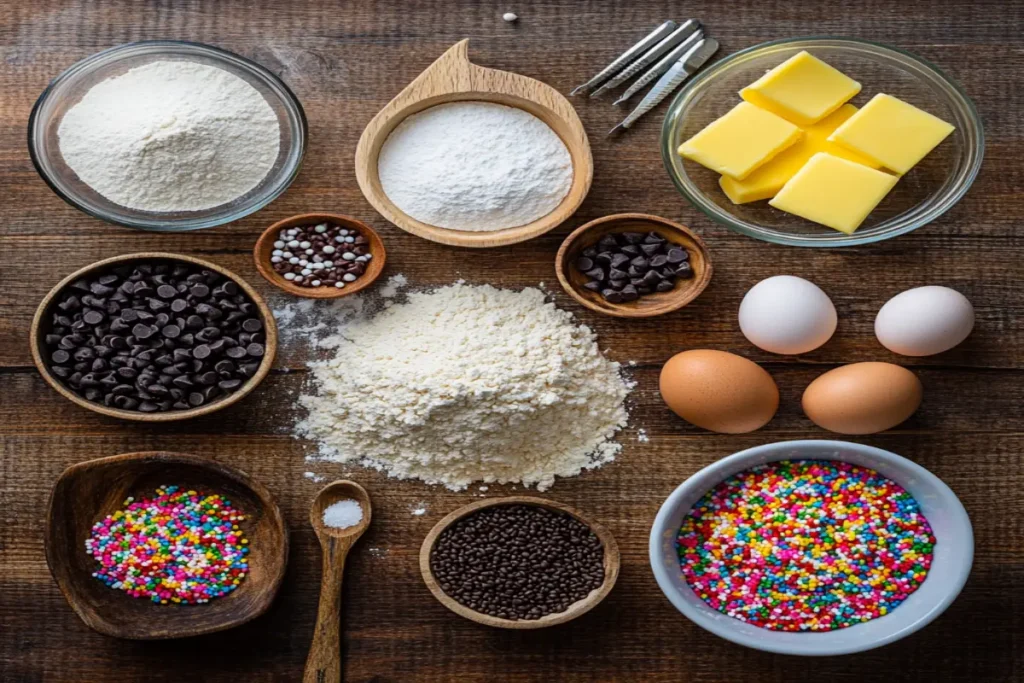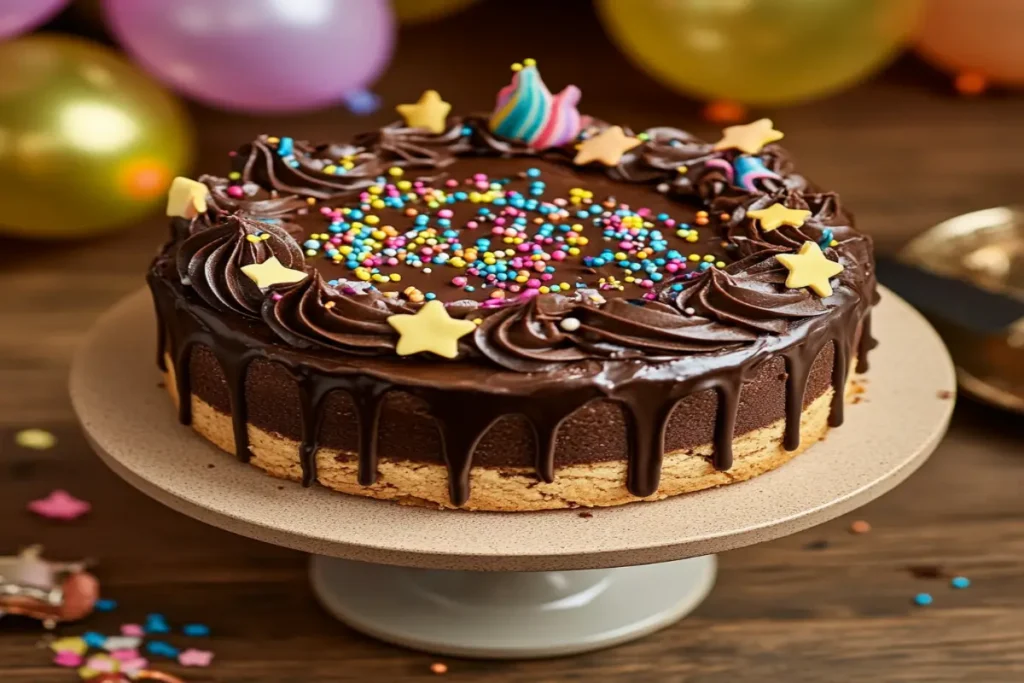Introduction
Cookie cakes have quickly become a favorite treat for celebrations because they combine the best aspects of cookies and cakes into one irresistible dessert. Moreover, their chewy texture and rich flavors make them ideal for birthdays, holidays, or even satisfying a simple craving. In this guide, you’ll discover everything you need to know about crafting the perfect cookie cake, ranging from its fascinating history to expert decorating tips.
Table of contents
History
Cookie cakes originated in the United States when inventive bakers decided to create oversized cookies in a cake-like form. This idea gained significant popularity in the late 20th century, with companies such as Great American Cookies introducing giant cookies as festive desserts for special occasions.
- The idea of baking large cookies dates back to the invention of the chocolate chip cookie by Ruth Wakefield in the 1930s.
- Cookie cakes became a popular alternative to traditional birthday cakes due to their unique appearance and flavor.
Today, cookie cakes are a versatile dessert, enjoyed in various forms and flavors across the globe.
For a healthier spin on cookie baking, explore this almond flour chocolate cookie recipe that highlights a nutritious alternative to traditional ingredients.
Why Choose a Cookie Cake?
If you’re wondering why cookie cakes are such a hit, here’s what makes them special:
- Versatility: This dessert allows for endless customization with your preferred ingredients and decorations.
- Ease of Preparation: Making this treat is much simpler than assembling and frosting a traditional layered cake.
- Flavor Combination: It offers the perfect balance of rich cookie flavors and a soft, cake-like texture, making it a favorite choice.
For another festive variation, consider adding seasonal flair inspired by these pumpkin pie cookies.
Ingredients

To create a delicious cookie cake, you’ll need these basic ingredients:
- Flour: All-purpose flour works best for the ideal consistency.
- Sugar: Use a mix of white and brown sugar for a chewy texture and rich flavor.
- Butter: Opt for unsalted butter to control the salt level.
- Eggs: These add structure and moisture to your cookie cake.
- Chocolate Chips: The classic choice for any cookie cake, but feel free to experiment with other mix-ins.
- Vanilla Extract: A must-have for enhancing flavor.
- Baking Powder or Soda: Helps the cookie cake rise slightly for a soft texture.
With these ingredients, you can easily customize your recipe to suit your taste preferences.
For an alternative to pair with your dessert, try this easy milk bread recipe for a complementary fluffy and soft bread option.
Essential Tools for Baking a Cookie Cake
The right tools make baking a cookie cake easier and more enjoyable:
- Mixing Bowls: Use separate bowls for dry and wet ingredients.
- Whisk or Electric Mixer: Ensures smooth blending of ingredients.
- Baking Pan: A round or square pan works well for cookie cakes.
- Parchment Paper: Prevents the cookie cake from sticking to the pan.
- Measuring Cups and Spoons: For accurate ingredient measurements.
- Cooling Rack: Allows the cookie cake to cool evenly.
Investing in quality baking tools ensures consistent results every time.
Step-by-Step Recipe
Here’s a straightforward recipe to get you started:
Ingredients:
- 2 ½ cups all-purpose flour
- 1 tsp baking soda
- ½ tsp salt
- 1 cup unsalted butter, softened
- 1 cup brown sugar
- ½ cup granulated sugar
- 2 large eggs
- 2 tsp vanilla extract
- 2 cups chocolate chips
Instructions:
- Preheat the Oven: Set it to 350°F (175°C).
- Mix Dry Ingredients: In a bowl, whisk together flour, baking soda, and salt.
- Cream Butter and Sugar: In another bowl, beat butter, brown sugar, and granulated sugar until light and fluffy.
- Combine Wet Ingredients: Add eggs and vanilla extract, mixing well.
- Incorporate Dry Ingredients: Gradually mix the dry ingredients into the wet mixture.
- Add Chocolate Chips: Fold them into the batter.
- Prepare the Pan: Line a baking pan with parchment paper and spread the dough evenly.
- Bake: Bake for 20-25 minutes or until golden brown. Let it cool completely before decorating.
Tips and Tricks for a Flawless Cookie Cake
Achieving the perfect cookie cake requires attention to detail. Here are some expert tips:
- Don’t Overmix: Overmixing the dough can lead to a dense, tough cookie cake.
- Check for Doneness: Insert a toothpick into the center; it should come out clean with a few crumbs.
- Chill the Dough: For a thicker cookie cake, refrigerate the dough for 30 minutes before baking.
- Adjust Baking Time: If using a smaller pan, increase the baking time slightly.
These small adjustments can make a big difference in the texture and flavor of your cookie cake.
Decorating
The final touch to any cookie cake is its decoration. Here are some ideas:
- Frosting: Use buttercream, cream cheese frosting, or chocolate ganache to enhance flavor.
- Sprinkles: Add a pop of color with sprinkles or edible glitter.
- Personalized Messages: Pipe messages using a piping bag and frosting for special occasions.
- Toppings: Experiment with crushed nuts, caramel drizzle, or mini candies for added flair.
A beautifully decorated cookie cake makes any occasion extra special and adds a personal touch.
Popular Cookie Cake Flavors
The variety of flavors available for cookie cakes ensures there’s something for everyone. Each flavor highlights the versatility of this dessert, making it a favorite for different tastes.
- Classic Chocolate Chip: The timeless option with rich chocolate chunks baked into a buttery cookie base.
- Double Chocolate: Perfect for chocolate lovers, this cookie cake combines cocoa powder and chocolate chips.
- Peanut Butter: A nutty, rich flavor that pairs beautifully with chocolate drizzle or frosting.
- Funfetti: A colorful treat with rainbow sprinkles baked into the dough.
- Oatmeal Raisin: A slightly healthier option that’s soft, chewy, and full of natural sweetness.
- Red Velvet: A luxurious take, often paired with cream cheese frosting for added indulgence.
Each cookie cake flavor offers unique tastes and textures, allowing you to experiment with ingredients and find your favorite.
Healthy Alternatives to a Cookie Cake
For those seeking lighter options, healthy alternatives to traditional cookie cakes are increasingly popular. You can maintain the essence of a cookie cake while making it more nutritious.
- Use Whole Wheat Flour: Replace all-purpose flour with whole wheat or almond flour for added fiber.
- Swap Butter for Coconut Oil: Coconut oil provides a healthier fat alternative with a mild sweetness.
- Reduce Sugar: Substitute refined sugar with natural sweeteners like honey, maple syrup, or stevia.
- Incorporate Mix-Ins: Add nuts, seeds, or dried fruits instead of chocolate chips for a healthier crunch.
These small changes ensure that your cookie cake remains a delicious treat without compromising on health.
Storing and Preserving
Proper storage ensures your cookie cake stays fresh and flavorful for days. Follow these steps for the best results:
- Cool Completely: Ensure the dessert has fully cooled before storing to avoid moisture buildup and soggy texture.
- Wrap Well: Use plastic wrap or aluminum foil to cover it tightly, helping retain its freshness and moisture.
- Store at Room Temperature: Place it in an airtight container and keep it at room temperature for up to three days.
- Refrigerate for Longer Storage: For a shelf life of about a week, store it in the fridge after wrapping it securely.
- Freeze for Later: Slice the dessert, wrap individual portions in foil or freezer bags, and freeze for up to three months.
Cookie Cake for Every Occasion
Cookie cakes are ideal for any celebration, offering versatility and ease of customization for various events.
- Birthdays: Decorate with personalized messages and vibrant frosting for a standout birthday dessert.
- Holidays: Incorporate seasonal elements like peppermint during Christmas or pumpkin spice in the fall.
- Graduations: Celebrate achievements with themed designs or colors.
- Anniversaries: A cookie cake with elegant toppings like ganache or edible flowers adds a romantic touch.
- Casual Gatherings: Its simplicity makes it perfect for potlucks, picnics, or family dinners.
Other Desserts vs Cookie Cake

When compared to other desserts, cookie cakes stand out for their unique characteristics.
- Ease of Preparation: Unlike more intricate desserts like layered cakes or pies, this treat is straightforward and doesn’t require complex steps.
- Texture Variety: It offers a unique balance, combining the chewiness of cookies with the soft, tender qualities of cake.
- Customizability: Experimenting with flavors, add-ins, and decorations is simpler, allowing you to create a dessert tailored to any occasion.
- Serving Size: Its format makes it easy to slice and serve, making it a convenient option for gatherings of any size.
FAQ:
What is the difference between a cookie and a cookie cake?
A cookie is a small, single-serving baked treat, often crisp or chewy in texture. By contrast, a cookie cake is a much larger version baked in a pan, resembling the size and shape of a traditional cake. While it shares the same flavors as cookies, its thicker, softer texture makes it ideal for slicing and serving like a cake.
Why does cookie cake taste different?
The taste difference comes from the baking process and the structure. Cookie cakes are thicker, allowing for a softer and moister interior, while the edges remain slightly crisp. This balance enhances the caramelized sugar and buttery flavor. Additionally, toppings like frosting and decorative elements often add extra layers of sweetness and richness, setting it apart from regular cookies.
What kind of pan is best for cookie cake?
A round or rectangular baking pan works best for a cookie cake. A 9-inch or 10-inch round pan is commonly used, though you can also opt for square or springform pans for easier removal. Ensure the pan has a non-stick surface or is lined with parchment paper to prevent sticking and ensure even baking. A well-distributed heat source ensures that your cookie cake bakes evenly.
To know when your dessert is ready!
look for golden brown edges and a center that appears set but not overly firm. Insert a toothpick into the middle—it should come out with a few moist crumbs but no wet batter. Removing it from the oven at the right moment is essential to maintain its soft texture and avoid drying out from overbaking.
Why did my cookie cake sink?
Sinking can occur for several reasons:
- Underbaking leaves the center too soft to hold its structure.
- Excess leavening agents like baking soda or powder can cause the cake to rise too quickly and then collapse.
- Overmixing the batter introduces too much air, leading to structural instability.
To avoid sinking, carefully measure ingredients, bake until fully set, and avoid overmixing the dough.
Conclusion
Cookie cakes are a delightful blend of simplicity and creativity, making them a go-to dessert for any occasion. Their versatility, whether in flavors, healthy adaptations, or decorations, ensures they cater to diverse preferences. Additionally, proper storage techniques guarantee you can enjoy your cookie cake long after it’s baked. Whether you’re hosting a party or treating yourself, cookie cakes remain a timeless and beloved choice.

